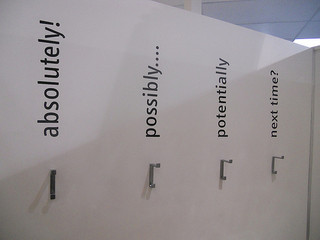My post last week on the importance of knowing what was in-store at the time of research fieldwork generated some fabulous feedback across a number of LinkedIn groups, and one particular question resonated.
What can be done, at the beginning of a shopper research project, to improve the chances of the work leading to action?
It’s a recurring question – and too often shopper marketers (and their bosses) are frustrated that; after taking the plunge to invest in shopper research, what they get in return is data, not actionable insights.
It’s a big and important question. More and more money is being spent on shopper research, and the value that many of us know that shopper marketing can bring to an organization is limited if there isn’t enough shopper understanding to back it up.
There are a whole bunch of things that can be done to improve the quality and focus of the research – so many that we’ve just finished writing an e-book on the subject – but here I’d like to share a few simple steps that will definitely improve the chances of being able to turn the outputs of your research into meaningful action.
Shopper Research is about enabling decisions to be made
 For an action to take place, a decision (or a set of decisions) needs to be made first. So, if you like, making shopper research actionable is about ensuring that the research outputs will support the decision-making which is required to create action. Of course this is no different in principal to any research project, but in the shopper realm it is complicated in a number of ways. One primary complexity is that the decision makers include not only those within the business, but those outside too, for example within retailers.
For an action to take place, a decision (or a set of decisions) needs to be made first. So, if you like, making shopper research actionable is about ensuring that the research outputs will support the decision-making which is required to create action. Of course this is no different in principal to any research project, but in the shopper realm it is complicated in a number of ways. One primary complexity is that the decision makers include not only those within the business, but those outside too, for example within retailers.
How to improve the chances that shopper research leads to action
Clearly define the potential actions that might come from the research
After all, this goes to the heart of why the research is being conducted in the first place. I find creating hypotheses really helps this process: a hypothesis creates a statement of what we believe prior to the research, and therefore the research should prove or disprove this. For example, a hypothesis along the lines of ‘floor displays do not drive incremental purchase’ helps define what might be done with the answer to this. If true, we may wish to reduce the number of displays, or invest in different activities.
Define who the decision makers would be
With clarity about the potential action, we can now think about who is likely to be involved in any decision required for that action to take place. If the potential action is to reduce the number of floor displays, we’re now in a position to understand who might be involved in making that decision. In this case, perhaps the key account manager and the buyer at the retailer.
Specify what information is required to make that decision
Decisions are made based on gut feel and data. Knowing who will make the decision (assuming you know them as people) will help you understand what their gut will tell them. Most retailers won’t be happy with a move to reduce investment in displays. So it’s important that we have strong data to support this argument. In this example, the retailer (and possibly the key account manager) are likely to fight anything which on the surface might have a negative impact on sales, and the retailer might also be concerned about a reduction of investment. This frames what the data must deliver. In this example the data would need to explain the impact on sales of removing floor displays, and would also potentially need to come up with an alternative activity to replace it.
Sense check the decision
At this point we know the action that needs to be taken, who will make the decisions, and the type of data that needs to be gathered. From this there is a simple ‘sense-check’ step. How likely – based on the magnitude of the decision, the likely data haul from the research, and what we know about the decision maker(s) as an individual or as individuals – is it that this decision is going to go our way and lead to action. If the answer is negative, then it’s time to reconsider the research. You may be right, maybe floor displays are a waste of money, but if nobody is going to implement the findings, then all you’re left with is self-satisfaction and frustration, neither of which delivers a great ROI on research investment.
At engage we see so many research projects that lead to no action; which merely frustrates everyone, and can create a vicious cycle of under-investment in understanding shoppers. These simple steps open up the possibility of significantly more action from research investment, and this leads to a virtual cycle of increased investment, and increased action. If you’d like to know more about how to get better results from shopper research, download our free e-book on conducting shopper research.
Feature image: Flickr





